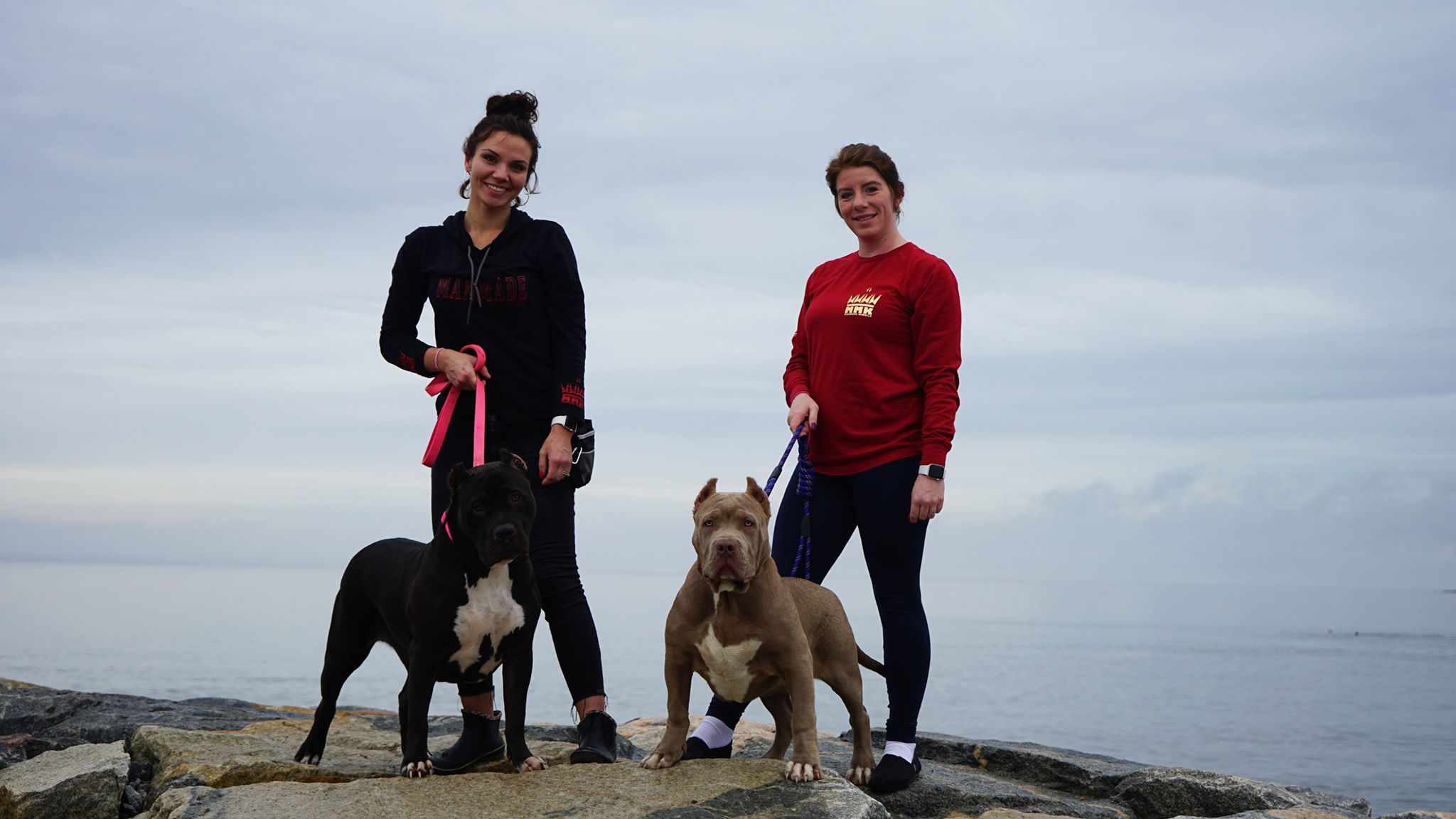Did you know that dogs with a high level of activity at a young age are susceptible to hip and joint problems? This means that without proper care, your blue nose or red nose pit bull puppies could very likely develop hip and joint problems as they age.
What are the causes of hip and joint problems in a pitbull
Hip and joint problems in pit bull puppies may be as a result of;
- Activity
- Weight
- Weak muscles
- Disease
- Genetics
- Injury
Pitbull Activity
A pit bull dog is naturally energetic and fun-loving. They love to run around, play a game of tug rope, or do up and downs to release pent up energy. All this activity slowly causes wear and tear in the pit bull’s hip and joints.
Wear and tear usually affect the connective tissue joining the hip to its socket. This tissue is known as cranial cruciate ligament and it is equivalent to the human anterior cruciate ligament. With repeated use, this tissue gradually wears off leaving the hip joint vulnerable to injury. Pit bull puppies are developing as they age, allowing them to jump out of trucks, run on the beach, and become to active; may cause joint problems.
Pitbulls Body Weight
Obesity is a leading cause of hip and joint problems in a puppy pitbulls. Muscular pitbulls like a red nose and blue nose XXL pit bull dogs tend to show the effects of the weight at around 7 to 8 years of age. The excess weight exerts pressure on the joints causing gradual wear and tear.
Pitbulls with Weak muscles
Muscles exert a pull on the joint allowing both humans and animals to move. If a pit bull terrier has weak muscles, it affects the integrity of their joints. Muscles also hold the joints together helping your dog hold its weight better. This is especially true for an XXL pit bull puppy.
Common Pitbull Diseases
There are degenerative diseases that cause hip and joint problems in dogs. They include;
- Arthritis
- Hip dysplasia
Arthritis causes hip and joint inflammation in pit bull dogs. The common type of arthritis in pit bull dogs is osteoarthritis. It affects the hips, lower back, elbows, wrists, and knees. The natural layer that lubricates joints wears off causing friction between the joint bones. This results in painful inflammation and reduced mobility in a dog.
Hip dysplasia is another major cause of joint problems in a pit bull. Here the femur bone (thigh bone) head is too large to fit into the hip socket. As the pit bull puppy grows, the hip bones fail to work smoothly and instead rub on each other. This excess friction causes inflammation and pain in the dog.
Pitbull Genetics
All dog breeds can suffer hip and hind pain. The larger breeds are more susceptible to this condition compared to medium-sized dogs or toy breeds. Pit bulls, Rottweilers, German Shepherd, and the Golden Retriever are common large breed dogs that are genetically predisposed to hip and joint problems.
Pitbull Injury
Too much play can cause hip and hind issues in a pit bull puppy. Also, if your pit bull dog suffered a joint injury before, he is likely to develop hip and hind problems if not properly rehabilitated. Allow ample time for your puppy to recover before re-engaging in high risk activities. Allowing your pit bull puppy to play ruff with their bigger brothers and sisters can easily cause an injury. Ensure your puppy is protected from being bullied around on the yard.
Is there a cure for hip and joint problems in a puppy pitbulls?
Hip and joint problems can be very difficult to treat in a puppy pit bull. But with proper care and rehabilitation, a pit bull dog with such problems can still thrive.
There are two ways to address joint problems in pit bull dogs;
- Corrective surgery
- Non-invasive care
Corrective Hip and Joint Surgery
Surgery is one way of correcting hip and hind problems in a pit bull dog. But there are several downsides to this procedure. One is that it can be costly to perform corrective surgery on a puppy pit bull with hip and hind issues. Pet owners have had to cough as much as $1700 for successful corrective surgery.
Secondly, surgery is only recommended in puppies and young pit bull dogs. If your bluenose or red nose pit bull is a senior, this option will not work for him. Thirdly, surgery is an invasive procedure that has a longer recovery time. The rate of recovery will depend on the quality of post-surgical care, age, and health of the dog.
Corrective surgery is mostly recommended on a puppy pitbull. This gives the canine ample time to heal and the joint bones to align properly.
Non-invasive ways to manage hip and joint problems in a puppy pit bull
Fortunately, there are ways to manage hip and joint problems in a pitbull without subjecting your furry friend to the cut. Some of the non-invasive ways to promote joint health in pit bulls include;
- Hydrotherapy
- Acupuncture
- Massage therapy
- Supplements
Hydrotherapy for puppy pit bull
Hydrotherapy uses water to promote healing in the body. This therapy technique is used to address arthritis in dogs. The physician uses a swimming pool with water temperatures between 33 and 36 °C to induce healing.
Hydrotherapy combines water temperature with mechanical body movements to trigger healing. Water pressure constantly kneads the muscles and sending soothing sensations to the body nerves. Also, hydrotherapy uses hot and cold waters to speed up healing.
Hot water helps soothe and quieten the body. It also slows down internal physiological processes and channels all energy towards healing your pit bull's hip and hind issues. Cold water stimulates the nerves and invigorates the muscles. It also helps boost blood circulation and encourage activity.
Acupuncture for pit bull dogs
Acupuncture or acupressure for dogs focuses on restoring the balance in internal body energy called Chi. When your Chi is balanced, everything else falls in place which includes healing of ailing hip and hinds.
Fine needles are inserted in specific areas known as acupressure points. The main acupressure points in a puppy pit bull include;
- Between the eyes or Yin Tang
- The Tempos or Yang Tang
- Lower Back or Baihui
- Stomach
- Hinds and Paws or Shen Men
The needles help guide energy flow through the body. This, in turn, helps improve blood circulation. Acupuncture also stimulates the nerves and heightens the release of anti-inflammatory hormones to speed up healing.
Massage Therapy
Canine massage has been around for years. It is a technique that provides relief to your dog by relaxing tensed muscles. Canine massage therapy helps in;
- Relaxing the dog and promoting a good mood
- Improving blood circulation in the body
- Improving the flexibility of joints
- Reducing inflammation from arthritis and discomforts caused by hip dysplasia
- Providing relief from muscle tension, weakness, soreness, or spasms.
You should start to notice improvements after massaging your pit bull puppy once or twice a week.
Vitamin Supplements
Healthy pet supplements can help reduce inflammation and speed up the healing process. Glucosamine, fish oil, and turmeric are some of the supplements that vets recommend for pit bulls with hip and joint problems.
Turmeric reduces inflammation and boosts the body's immune system. Glucosamine repairs worn-out cartilages in the dog's joint. This amino sugar also carries anti-inflammatory properties that help provide relief to aching joints. Fish oil provides relief for joint pain to pit bull dogs with hip and hind problems.

